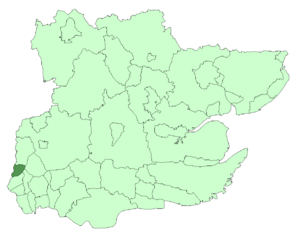Municipal Borough of Chingford facts for kids
| Chingford | |
| Motto: All Things for the Glory of God | |
 Chingford Town Hall |
|
 Chingford within Essex in 1961 |
|
| Geography | |
| Status | Urban district (until 1938) Municipal borough (after 1938) |
| 1911 area | 2,808 acres (11.4 km2) |
| 1931 area | 2,810 acres (11.4 km2) |
| 1961 area | 2,868 acres (11.6 km2) |
| HQ | The Ridgeway |
| History | |
| Origin | Chingford parish |
| Created | 1894 |
| Abolished | 1965 |
| Succeeded by | London Borough of Waltham Forest |
Quick facts for kids Demography |
|
|---|---|
| 1911 population - 1911 density |
8,184 2.9/acre |
| 1931 population - 1931 density |
22,053 7.8/acre |
| 1961 population - 1961 density |
45,787 15.9/acre |
| Politics | |
| Governance | Chingford Urban District Council Chingford Borough Council |
 Coat of arms of the borough council |
|
Chingford was a special area in south west Essex, England. It had its own local government from 1894 to 1965. This area was located around the town of Chingford. It was part of the bigger London postal district and the Metropolitan Police District. Today, the area that used to be Chingford is the northern part of the London Borough of Waltham Forest in Greater London.
How Chingford's Local Government Started
The old area of Chingford was once a "parish." A parish was like a small local area, often linked to a church. It was part of a larger region called the Waltham Hundred in Essex.
In 1834, a law called the Poor Law Amendment Act 1834 changed how local areas helped people in need. Chingford became part of the Epping Poor Law Union. This was a group of parishes working together.
Later, in 1875, Chingford became part of the Epping Rural Sanitary District. This group helped manage public health, like clean water and waste.
Then, in 1894, Chingford got its own special status. It became an urban district. This meant it had its own local council to manage things like roads and services.
Chingford: From District to Borough
In 1932, there was a plan to combine Chingford with another area called Waltham Holy Cross. The idea was to create a new, larger urban district. However, the people in Waltham Holy Cross did not agree with this plan. One reason was that there was no direct train line between the two areas.
Because of this, the plan to merge them did not happen. Instead, in 1934, only a small piece of land was moved from Waltham Holy Cross to Chingford.
Chingford's local government status changed again in 1938. It became a municipal borough. This was a step up from an urban district, giving it more power to govern itself.
The End of Chingford's Separate Government
In 1960, a special group called the Royal Commission on Local Government in Greater London looked at Chingford. They decided it should become part of a larger area called Greater London.
So, in 1963, a new law called the London Government Act 1963 was passed. This law officially ended Chingford's separate local government. Its area was moved from Essex to Greater London.
Chingford was then combined with two other areas: the Municipal Borough of Walthamstow and the Municipal Borough of Leyton. Together, these three areas formed the new London Borough of Waltham Forest. This is how the area is governed today.

